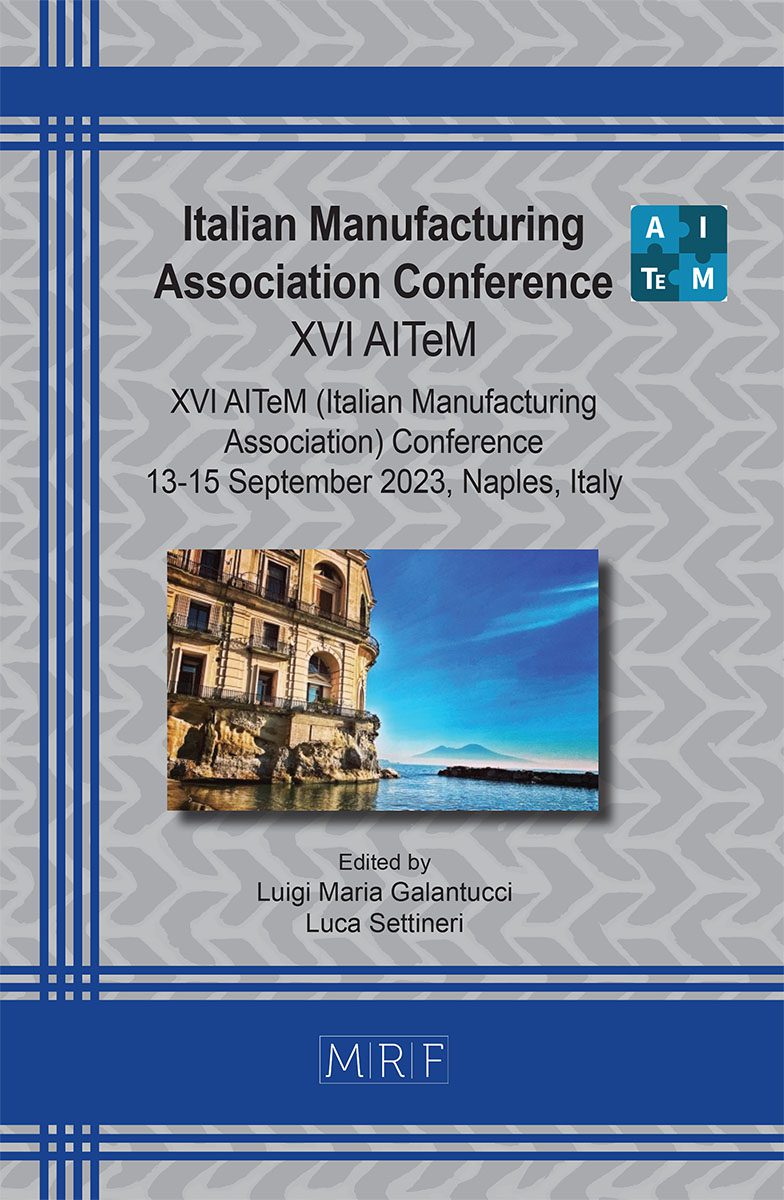Reverse bending fatigue of 316L stainless steel components produced by laser powder bed fusion
Stefano Guarino, Emanuele Mingione, Gennaro Salvatore Ponticelli, Simone Venettacci
download PDFAbstract. The freedom to manufacture metal components with very complex geometries using additive manufacturing techniques, such as laser powder bed fusion (LPBF), has opened new possibilities to produce innovative solutions with a high technological impact. It is therefore pivotal to have a detailed knowledge of the performance characteristics, both in the short and in the long term. Within this framework, this study firstly highlights the monotonic tensile properties of the LPBF samples by changing the laser scanning speed, the layer thickness, and the building orientation. Then, within the same process conditions, the fatigue life is investigated through reverse bending loading tests. The results verify an improved resistance, a reduced rigidity, and a strong anisotropy for the LPBF specimens if compared to the bulk material. The dependence on the orientation, together with the porosity of the LPBF samples, are the primarily responsible for the reduction of the fatigue limit.
Keywords
Laser Powder Bed Fusion, 316L Stainless Steel, Fatigue Life
Published online 9/5/2023, 9 pages
Copyright © 2023 by the author(s)
Published under license by Materials Research Forum LLC., Millersville PA, USA
Citation: Stefano Guarino, Emanuele Mingione, Gennaro Salvatore Ponticelli, Simone Venettacci, Reverse bending fatigue of 316L stainless steel components produced by laser powder bed fusion, Materials Research Proceedings, Vol. 35, pp 173-181, 2023
DOI: https://doi.org/10.21741/9781644902714-21
The article was published as article 21 of the book Italian Manufacturing Association Conference
![]() Content from this work may be used under the terms of the Creative Commons Attribution 3.0 license. Any further distribution of this work must maintain attribution to the author(s) and the title of the work, journal citation and DOI.
Content from this work may be used under the terms of the Creative Commons Attribution 3.0 license. Any further distribution of this work must maintain attribution to the author(s) and the title of the work, journal citation and DOI.
References
[1] Shin, W.S.; Son, B.; Song, W.; Sohn, H.; Jang, H.; Kim, Y.J.; Park, C. Heat Treatment Effect on the Microstructure, Mechanical Properties, and Wear Behaviors of Stainless Steel 316L Prepared via Selective Laser Melting. Materials Science and Engineering: A 806 (2021). https://doi.org/10.1016/j.msea.2021.140805
[2] Mehrpouya, M.; Vosooghnia, A.; Dehghanghadikolaei, A.; Fotovvati, B. The Benefits of Additive Manufacturing for Sustainable Design and Production. Sustainable Manufacturing (2021) 29-59. https://doi.org/10.1016/B978-0-12-818115-7.00009-2
[3] Ponticelli, G.S.; Tagliaferri, F.; Venettacci, S.; Horn, M.; Giannini, O.; Guarino, S. Re-Engineering of an Impeller for Submersible Electric Pump to Be Produced by Selective Laser Melting. Applied Sciences (Switzerland) 11 (2021). https://doi.org/10.3390/app11167375
[4] Gardner, L. Metal Additive Manufacturing in Structural Engineering – Review, Advances, Opportunities and Outlook. Structures 47 (2023) 2178-2193. https://doi.org/10.1016/j.istruc.2022.12.039
[5] Yasa, E. Selective Laser Melting: Principles and Surface Quality. Addit Manuf (2021). https://doi.org/10.1016/B978-0-12-818411-0.00017-3
[6] Ponticelli, G.S.; Venettacci, S.; Giannini, O.; Guarino, S.; Horn, M. Fuzzy Process Optimization of Laser Powder Bed Fusion of 316L Stainless Steel. Prog. Addit. Manuf. (2022). https://doi.org/10.1007/s40964-022-00337-z
[7] Liu, Y.; Zhang, M.; Shi, W.; Ma, Y.; Yang, J. Study on Performance Optimization of 316L Stainless Steel Parts by High-Efficiency Selective Laser Melting. Opt Laser Technol 138 (2021). https://doi.org/10.1016/j.optlastec.2020.106872
[8] Blinn, B.; Ley, M.; Buschhorn, N.; Teutsch, R.; Beck, T. Investigation of the Anisotropic Fatigue Behavior of Additively Manufactured Structures Made of AISI 316L with Short-Time Procedures PhyBaL LIT and PhyBaL CHT. Int J Fatigue 124 (2019) 389-399. https://doi.org/10.1016/j.ijfatigue.2019.03.022
[9] Riemer, A.; Leuders, S.; Thöne, M.; Richard, H.A.; Tröster, T.; Niendorf, T. On the Fatigue Crack Growth Behavior in 316L Stainless Steel Manufactured by Selective Laser Melting. Eng Fract Mech 120 (2014) 15-25. https://doi.org/10.1016/j.engfracmech.2014.03.008
[10] Casati, R.; Lemke, J.; Vedani, M. Microstructure and Fracture Behavior of 316L Austenitic Stainless Steel Produced by Selective Laser Melting. J Mater Sci Technol 32 (2016) 738-744. https://doi.org/10.1016/j.jmst.2016.06.016
[11] Tucho, W.M.; Lysne, V.H.; Austbø, H.; Sjolyst-Kverneland, A.; Hansen, V. Investigation of Effects of Process Parameters on Microstructure and Hardness of SLM Manufactured SS316L. J Alloys Compd 740 (2018), 740, 910-925. https://doi.org/10.1016/j.jallcom.2018.01.098
[12] Kocks, U.F.; Mecking, H. Physics and Phenomenology of Strain Hardening: The FCC Case. Prog Mater Sci 48 (2003) 171-273. https://doi.org/10.1016/S0079-6425(02)00003-8
[13] Saeidi, K.; Akhtar, F. Subgrain-Controlled Grain Growth in the Laser-Melted 316 L Promoting Strength at High Temperatures. R Soc Open Sci 5 (2018). https://doi.org/10.1098/rsos.172394
[14] Lemaitre, J.; Desmorat, R. Engineering Damage Mechanics: Ductile, Creep, Fatigue and Brittle Failures; 1st ed.; Springer: Berlin (2005).
[15] ASM International Fatigue. In Elements of Metallurgy and Engineering Alloys; ASM International, Ed.; ASM International: Ohio (2008) 243-264. https://doi.org/10.31399/asm.tb.emea.t52240243
[16] Pellizzari, M.; AlMangour, B.; Benedetti, M.; Furlani, S.; Grzesiak, D.; Deirmina, F. Effects of Building Direction and Defect Sensitivity on the Fatigue Behavior of Additively Manufactured H13 Tool Steel. Theoretical and Applied Fracture Mechanics 108 (2020). https://doi.org/10.1016/j.tafmec.2020.102634
[17] Fotovvati, B.; Namdari, N.; Dehghanghadikolaei, A. Fatigue Performance of Selective Laser Melted Ti6Al4V Components: State of the Art. Mater Res Express 6 (2018). https://doi.org/10.1088/2053-1591/aae10e












